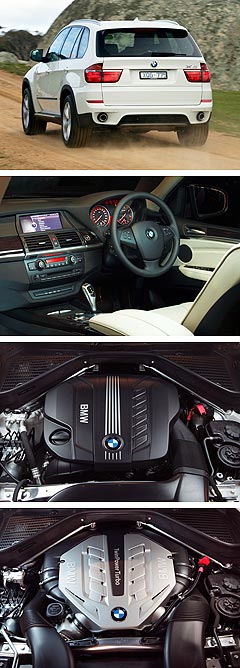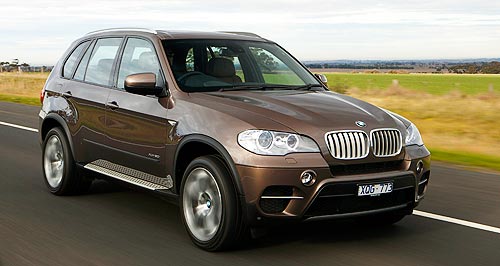New models - BMW - X5First drive: BMW primes X5 for luxury SUV battleFuel saver: BMW has added a new fuel-saving eight-speed ZF transmission to its X5 range. BMW X5 makeover brings more diesel and petrol power and economy - at a price7 Jul 2010 BMW’s X5 has been a favourite among the luxury SUV set since its launch in Australia in 2000 and since then it has spawned a family of SUV siblings in the X3, X6 and, most recently the X1. Some 27,219 X5s have been registered here to June 2010, continuing its record as the country’s top-selling luxury SUV for the past seven years. The second-generation X5, launched in 2007, cemented its position at the top as fresh competition from new models vied for a slice of the lucrative pie. Just as the original E53 X5 received a mid-life facelift four years into its tenure, the MkII E70 X5 now benefits from a host of upgrades after a similar period. The changes centre on new models, however, the range continues with four variants in the standard line up, supplemented by the sports-orientated X5 M at the head of the range. The X5 remains a luxurious, road-oriented SUV and the upgrades take that further as BMW aims to increase the sporting appeal and elegant style of the model. Entry to the hallowed X5 club has gone up almost $5500 in price due to the deletion of the xDrive30i petrol variant, which previously served as the entry model. The new starting price is $92,100 and for that you get the X5 xDrive30d. The single-turbo diesel 3.0-litre xDrive30d produces 173kW and 520Nm, up 7kW and 20Nm from the old model, but delivers a significant 15 per cent improvement in fuel consumption over the older model at 7.4L/100km. CO2 emissions are also reduced from 231g/km to 195g/km. Much of the decrease in fuel use comes from the application of a new eight-speed automatic transmission from ZF that is now standard across the X5 range. On its own, the ZF8HP – ironically, the same transmission recently introduced to X5 competitors in the new Touareg, Cayenne and Range Rover TDV8, and set to come on the upgraded Audi Q7 – is claimed to improve fuel consumption by up to 11 per cent.  The xDrive30d might be the entry-level but it doesn’t fall short on standard equipment, which includes 18-inch alloy wheels, leather trim, Servotronic power steering, brake energy regeneration, diesel particulate filter, front head and side airbags, active head restraints, an iDrive controller, Bluetooth phone connectivity, an electronic park brake, rain-sensing wipers, automatic headlights, hill descent control and electronic stability and traction control. The xDrive30d might be the entry-level but it doesn’t fall short on standard equipment, which includes 18-inch alloy wheels, leather trim, Servotronic power steering, brake energy regeneration, diesel particulate filter, front head and side airbags, active head restraints, an iDrive controller, Bluetooth phone connectivity, an electronic park brake, rain-sensing wipers, automatic headlights, hill descent control and electronic stability and traction control.Around 85 per cent of xDrive30d buyers choose accessory packages to spec up their vehicles and the Executive Package has been exclusively created for this model. It adds a rear-view camera with ‘top view’, anti-dazzle interior/exterior mirrors, power seat adjustment and Professional navigation to the equipment list. These options would normally add $9400 to the purchase price but bought as a package they cost $7000. Without the xDrive30i in the range, the petrol X5 line-up now starts at more than $100,000, with the xDrive35i priced at $103,900. While the six-cylinder engine retains its 3.0-litre capacity the XDrive35i uses twin turbochargers to boost power to 225kW and torque to 400Nm – up from the non-turbocharged engine’s 200kW and 315Nm. The result is a drop of 1.3 seconds – to 6.8 seconds – for the 0-100km/h dash, while at the same time reducing fuel consumption from 11.7 to 10.1L/100km. Next step up is the second diesel-engined X5, the X5 xDrive40d Sport, at $113,300. The Sport designation indicates that the ‘Sport’ package, which is optional on xDrive30d and xDrive35i models, comes standard. The Sport package includes a choice of two new alloy wheel designs, a sports leather steering wheel, BMW Individual anthracite roof lining and firmer sports suspension. The sports suspension can be deleted at no extra cost and this is often preferred on Australia’s less than smooth roads, on which BMW’s already firm suspension and run-flat tyres can feel harsh. The xDrive40d Sport replaces the xDrive35d in the range and its 3.0-litre, twin-turbo direct-injection diesel engine has been tweaked to deliver 15kW and 20Nm more than the previous model. That puts it at 225kW and a thumping 600Nm of torque enough to propel the X5 to 100km/h in just 6.6 seconds – down from 7.0 seconds. Also down is fuel consumption, to 7.5L/100km – a drop of 15 per cent. As in previous iterations, the range-topping X5 is powered by a V8 petrol engine, but the 4.8-litre V8 of the xDrive48i is gone and in its place is a smaller-capacity, 4.4-litre twin-turbocharged V8 engine from the X6. The X5 xDrive50i Sport, to use its full title, benefits from an extra 39kW and an incredible 125Nm of boost to deliver 0-100km/h acceleration in just 5.5 seconds. Peak figures are 300kW and 600Nm, while maximum torque is available from just 1750rpm through to 4500rpm. Fuel consumption for the V8 remains unchanged at 12.5L/100km, indicating that the twin-turbocharged 4.4 engine is thirstier than the naturally aspirated 4.8, but is helped out by the new eight-speed transmission. As indicated by the nomenclature, the X5 xDrive50i Sport has the Sports pack as standard, but in this case self-leveling rear suspension is also included. Pricey options can add considerable expense to many European vehicles and the X5 doesn’t escape this phenomenon. BMW has bundled many popular options together and made them available as packages to make tailoring the vehicle simpler and less costly. As well as the Sports and Executive packages already mentioned, an M Sport package is available on all four models. It adds a deeper front bumper, 20-inch alloy wheels and V8-style exhaust tips on all engine variants. Sports suspension is also a part of the M Sport package, but again it can be deleted if a softer ride is preferred over more dynamic handling. The Innovations package adds convenience features including Comfort Access, bi-Xenon headlights, high beam assist, head-up display, an automatic tailgate and a sunroof at a reduced cost. On the X5 xDrive50i Sport, an alarm system and metallic paint are also included in the package. You’ll need to be an X5 enthusiast to spot the external changes to the new model. They are limited to a new front bumper fascia with larger air-intakes and, at the rear, a redesigned bumper and new-style LED tail-lights. X5s fitted with bi-Xenon headlights (standard on XDrive50i or included in the Innovations package) also have LED daytime running lights encircling the main headlight rims. Inside, the changes are limited to a choice of five colours for the Nevada leather trim, but there are a few driver aids that have become available as options, including active cruise control, lane departure warning, side view cameras and the top-view reversing camera. The X5 has been so popular in Australia and the rest of the world that it is now a stalwart in BMW’s line-up, representing a large proportion of total sales and always holding the lion’s share of X-vehicle sales over the less popular X3 and quirky X6. That could change with the new and cheaper X1 compact luxury SUV coming to market this year and an all-new X3 due next year, but for now its latest upgrades should see the X5 remain at the top of BMW’s SUV tree – and Australia’s luxury SUV sales chart.
 Quick testsRead moreAll new models Alfa Romeo Alfa Romeo Abarth Abarth Alpine Alpine Alpina Alpina Audi Audi Aston Martin Aston Martin BMW BMW Bentley Bentley Chery Chery Brabham Brabham Chrysler Chrysler Chevrolet Chevrolet Cupra Cupra Citroen Citroen DS DS Dodge Dodge Fiat Fiat Ferrari Ferrari Foton Foton Ford Ford Great Wall Great Wall FPV FPV Haval Haval GWM GWM Honda Honda Holden Holden Hyundai Hyundai HSV HSV Isuzu Isuzu Infiniti Infiniti Jeep Jeep Jaguar Jaguar Lamborghini Lamborghini Kia Kia LDV LDV Land Rover Land Rover Lotus Lotus Lexus Lexus Maserati Maserati Mahindra Mahindra McLaren McLaren Mazda Mazda Mercedes-Benz Mercedes-Benz Mercedes-AMG Mercedes-AMG Mini Mini MG MG Nissan Nissan Mitsubishi Mitsubishi Pagani Pagani Opel Opel Porsche Porsche Peugeot Peugeot Ram Ram Proton Proton Rolls-Royce Rolls-Royce Renault Renault Saab Saab Rover Rover Smart Smart Skoda Skoda Subaru Subaru SsangYong SsangYong Tesla Tesla Suzuki Suzuki Toyota Toyota Volvo VolvoX5 pricing
Motor industry news |
|
||||||||||

















Facebook Twitter Instagram